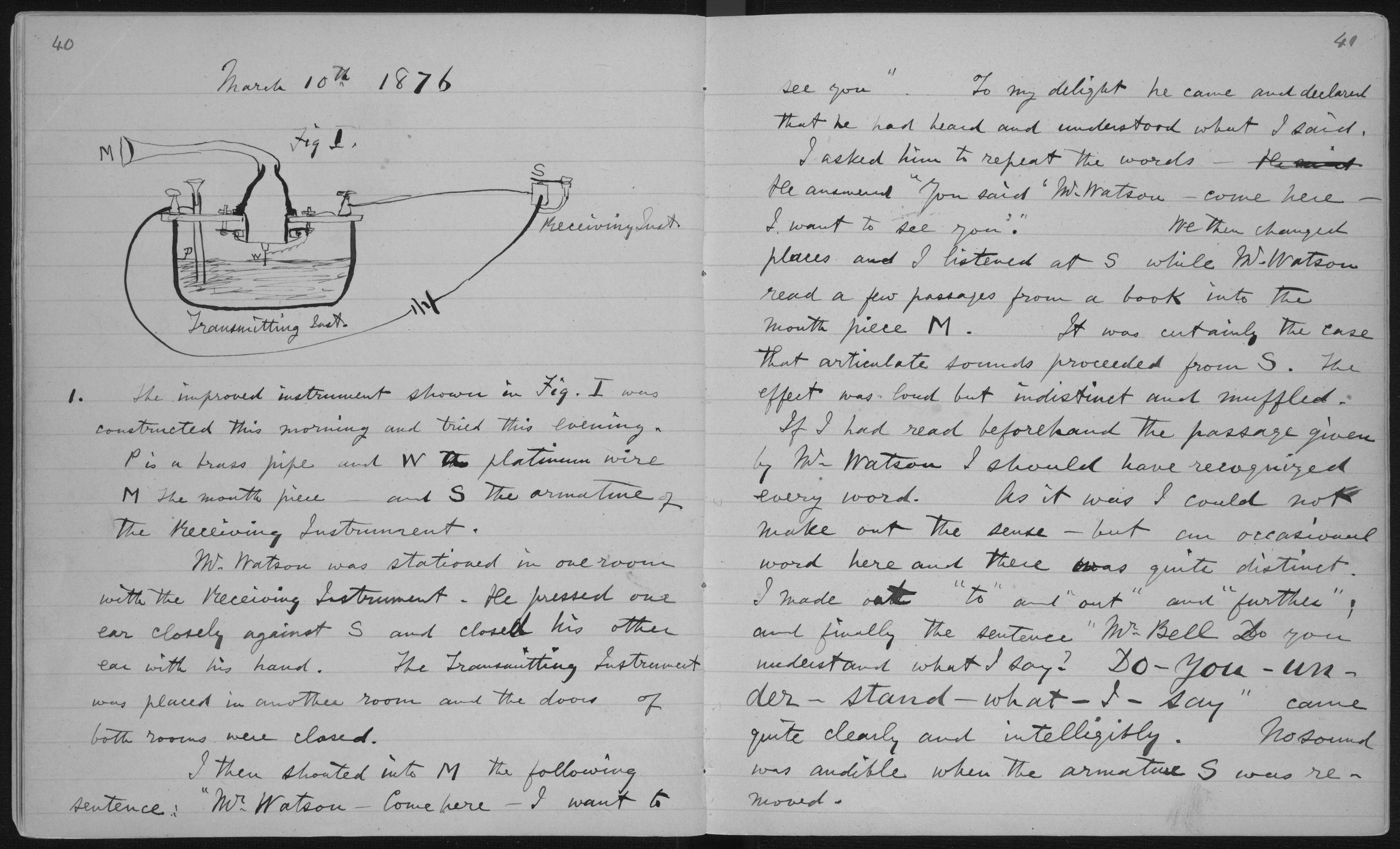lablog: a jekyll template
lablog: a jekyll template
This is a template for the static site generator Jekyll. based on Jekyll’s default theme by jglovier. It adds functionality that targets at the use as a lab notebook, research log and knowledge base, for you personally or for collaborative work.
What is a lab notebook?
Researchers use a lab notebook to document their hypotheses, experiments and initial analysis or interpretation of these experiments. The notebook serves as an organizational tool, a memory aid, and can also have a role in protecting any intellectual property that comes from the research.
says Wikipedia

Pages 40-1 of Alexander Graham Bell’s unpublished laboratory notebook (1875-76), describing first successful experiment with the telephone. Source: Wikimedia Commons
So my idea is to make a blog that facilitates
- writing of daily logs
- collecting and linking information
- drafting of articles and essays
- building a knowledgebase
What is Jekyll?
Jekyll is a static site generator that parses a collection of simple textfiles (using a minimalist Markup) into static websites.
Details
Features:
- Todo Lists using the GitHub syntax
- [ ]. - Tags allow you to link posts of a certain topic, project or field of interest. Buttons for the next and previous post and automatic linking to related posts based on common tags facilitates browsing through posts.
- Post Archive is a chronological list of all posts, which is perfect for the use as a lab diary.
- Multi-authoring for entire research groups due to an
authortag in the front-matter - log your geolocation with the
placeparameter - math equations using mathjax.org (renders $ \LaTeX $ syntax).
Requirements
- Jekyll
- a convenient text editor (e.g. Geany, Notepad, Notepad++, Atom)
Recommended:
- git
- a Dropbox or GitHub account, or access to a webserver (for Deployment)
Set-up
You can clone this repository
git clone git@github.com:fdschneider/jekyll-lablog.git
and use jekyll serve to run it locally. It will be available in your browser under the URL localhost:4000.
Use
new posts
Just create a new file in the _posts directory with a filename of the scheme YYYY-MM-DD-title.md (file ending .md is for Markdown but other filetypes are possible) and add a YAML front matter, which is two lines of three dashes each, with some information about your post in between:
---
title: "My newest post"
tags:
- soup
- conferences
---
This is about soup, and conferences.
You do not necessarily need to enter any information. You could leave just an empty line between the dashes. But a title and tags make the log functional.
Posts are typically written in Markdown (Jekyll by default is using kramdown as a parser, but that can be configured).
Pages
Information beyond posts, content that deserves a special spot on your log, is placed in pages. These are markdown files placed in the base directory with a simple filename (not the year-month-day name as for posts). Examples are about.md, tags.md, index.html and archive.html. They are rendered into static pages using a slightly different layout and are granted a spot in your header (the menu) at the top of the page.
Task lists
You can create new task list files by setting them up with a frontmatter that specifies
---
layout: tasks
title : Tasks
---
## Project 1
- [ ] fix a bug in `soup.r`
- [ ] write an [e-mail to Steve]()
- [ ] write documentation
- [ ] for `soup.r`
- [x] soup recipe
- [x] read [that paper about soup]()
of course you can change the title, but the layout must be set as tasks. You can write nested task lists, which opens wonderful possibilities for project management. Imagine that tasks can use links to connect to posts on the site, to e-mail addresses, to websites.
Customize
A few things require your personalized entries, to link the log to your person and to deliver additional information about you and your affiliations.
Title and Author information
Add your site title and your name, e-mail address, github, twitter etc. in the _config.yml. They will show up in the footer of the website.
About page
Write a short page about you and your work. This is optional. The default about.md can be deleted from the directory.
License
If you intend to invite others to read and browse your lablog, you should chose a license or copyright specification to clarify how content on the lablog can be re-used. The lablog defaults to the open Creative Commons Attribution 4.0, which allows the non-commercial and commercial re-publication and even sublicensing of your work. Replace or delete this statement in the file _includes/footer.html.
Theme color
It is easy to change the color of links and the menu by setting a different color for the variable $brand-color in the style file css/main.scss.
Deployment
If you want to access the log from anywhere on the internet you will need one of the following solutions. For these you will have to specify the url and baseurl, as well as the target directory for generation destination: , parameters in _config.yml. Just enter the values described below.
Dropbox
In my opinion the perfect solution for a quick and semi-private deployment: Dropbox can serve a static site placed in the /Public folder. Just keep the log directory anywhere on your PC, but preferably in a private section of your Dropbox and specify destination: ../../Public/lablog , i.e. the relative path from your blog directory to the target directory. Then build your blog.
jekyll build
Now, wait for the sync to happen and go to your Dropbox account online, navigate to your public directory, and there to the lablog directory. Right-click on the index.html file to get the public link. The root of this link (without /index.html) will be required for the next step:
Then set
url: "https://dl.dropboxusercontent.com"
baseurl: "u/xxxxxx/lablog"
Now build again and navigate in your browser to https://dl.dropboxusercontent.com/u/xxxxxx/lablog/index.html
Save this long, cryptic link as a bookmark or to load at browser start. For the future, all you need is to re-run the simple jekyll build command each time you updated a file.
GitHub pages
Advantage:
- free
- publishable URL
- automatic deployment
- version control (enforced)
Disadvantage:
- no plugins allowed
- no control over Jekyll parsing and version used
GitHub.com is providing free webhosting of static web content. Even better it automatically deploys jekyll websites. You just have to create a branch called gh-pages, push it with your updated content to GitHub and in an instant the site will be refreshed.
Specify:
url: "https://user.github.com"
baseurl: "/lablog"
any other webserver
If you want to keep it truly private, the only solution will be hosting your jekyll blog on a webserver.
Features to come:
- dashboard-like index page (first 4-6 posts, tag-list and categories)
- improving Todo list
- filter for due date indicated by
due: XXXX-XX-XX - Milestone tag
<hX> Milestone: - switch: folding checked tasks of first level
- switch: folding second level
- folding of specific lists (button)
- filter for due date indicated by
- category pages
- make use of
site.categories[category] - read in of specific todo list, pages and posts
- github api?
- make use of
- easier linking between posts
- hash tags: replace
#tagwith<a href...>tag</a>
- hash tags: replace
- adding a global search
- facilitate open research
- provide Disqus hook??
- adding CC license selector
- move feeds link to footer
- sitemap.xml & robots.txt
- 404.html
- pdf-export template for pandoc
- manual for Rmarkdown or knitr
known bugs:
(please report at the issues page)
License
The MIT License (MIT)
Copyright (c) 2014 Florian D. Schneider
Permission is hereby granted, free of charge, to any person obtaining a copy of this software and associated documentation files (the “Software”), to deal in the Software without restriction, including without limitation the rights to use, copy, modify, merge, publish, distribute, sublicense, and/or sell copies of the Software, and to permit persons to whom the Software is furnished to do so, subject to the following conditions:
The above copyright notice and this permission notice shall be included in all copies or substantial portions of the Software.
THE SOFTWARE IS PROVIDED “AS IS”, WITHOUT WARRANTY OF ANY KIND, EXPRESS OR IMPLIED, INCLUDING BUT NOT LIMITED TO THE WARRANTIES OF MERCHANTABILITY, FITNESS FOR A PARTICULAR PURPOSE AND NONINFRINGEMENT. IN NO EVENT SHALL THE AUTHORS OR COPYRIGHT HOLDERS BE LIABLE FOR ANY CLAIM, DAMAGES OR OTHER LIABILITY, WHETHER IN AN ACTION OF CONTRACT, TORT OR OTHERWISE, ARISING FROM, OUT OF OR IN CONNECTION WITH THE SOFTWARE OR THE USE OR OTHER DEALINGS IN THE SOFTWARE.
